
| Buyer's Guide | |
| Advanced Stair Definitions and Terminology | |
Advanced Stair Definitions and TerminologyBelow is a list in alphabetical order of different parts of a staircase, as well as the terms that are used by stairbuilders. A Apron - A trim board attached to a vertical surface used to support the projected edge of a window stool or landing nosing (See also Fascia). B Balanced Steps - Winders that do not radiate from a common center but are distributed uniformly through equal segments of the walk line . Also called dancing steps. Balcony - An elevated area of floor with a balustrade visible from below. Balusters - A vertical member used to in-fill and restrict the size of openings within a balustrade and/or provide support to the top of a balustrade or guard system by transferring a portion of the load applied to the balustrade to the structure of a stair or floor system. Balusters, Raked - Balusters with plinths or end blocks that follow the rake or inclination of the stair. Balusters, Stepped - Balusters with plinths that are of uniform height above the tread. Balustrade - A system of rails, newels, balusters, panels or other ornamental components used to separate two areas. Balustrades used to minimize falls from elevated walking surfaces and the sides of stairs are also guards. Banister - A simple post-to-post balustrade typically with small diameter, square or rectangular section balusters used to provide a handrail and minimize falls from the side of stairs. Bending Rail - Thin, flexible, longitudinal-sections of a rail profile that are molded individually such that bending and laminating the strips together will provide a curved rail in the composite profile of the combined strips. Blocking - Wood blocks or other elements attached to the building structure to provide for the transfer of loads and/or the secure fastening of objects at points between structural elements such as studs or joists where voids in the structure would not permit secure fastening. Bowed Riser - A riser that is curved in plan to provide balanced winders. Box Newel - A newel, usually square in section, often made as a "box" with a hollow center, from boards joined at the corners. Bracket - 1: A triangular structural support element used to transfer loads from one element to another by changing the direction of the applied load. 2: A support used to attach a handrail to a wall. 3: An element connecting the tread and riser usually applied to the face stringer as a decoration. 4: An element attached to a stringer to support a tread. Bullnose - 1: A descriptive term for a radius moulding profile applied to the edge of a moulding. 2: A type of starting step with half circular end(s) in plan projecting beyond the width of the stairs above. 3: A moulding with a rounded edge such as a landing tread or landing nosing. C Cap - 1: A moulded object or board used to finish the top of an object such as a wall, or closed stringer. 2: That part of a rail fitting that is attached the top end of a newel. 3: The applied top of a box newel. Cap, Tandem - A horizontal rail fitting used to connect two rails at an angle of 180-degrees at the top of a newel. Cap, Opening - 1: A horizontal rail fitting at the start of a level balustrade system at the top of a newel. (See Cap) 2: A horizontal rail fitting used as a component of a starting easement at the top of a starting newel. Cap, Quarter Turn - A horizontal rail fitting used to connect two rails at an angle of 90-degrees at the top of a newel. Circular stair - A curved stairway that is circular in plan. Closed string - A stringer that closes the ends of the treads and risers typically with the top edge following the angle of the stair. Curb Stringer - A buttress stringer. Curtail Step - See Volute step. Curved stair - A stair with some portion having an arc in plan that is a radius, elliptical or a combination of radii. Cut String - A stringer cut or notched on the upper edge to fit the profile of the stairs (see also Open String). Cut Stringer, Mitered - A cut stringer with the riser cuts mitered to accept a riser with a complimentary miter. D Dextral stair - A stair that turns to the right during ascent. Dogleg stair - A stair with two flights separated by a half landing, and having no stairwell, (in elevation the angles of the flights form a dogleg shape). Drop - An ornamental element used at the bottom end of a newel. E Easing - 1: An arc that is tangent to two straight intersecting lines providing a smooth rounding instead of an angular intersection. 2: An easement in a rail or stringer, i.e. up easing, over easing. 3: Sanding or shaping a radius on the corner of a board to yield an "eased edge". Easement - A component that provides a vertically curved easing between two intersecting rails or a rail and cap as in a starting easement. F Face Stringer - The exposed stringer on the open side of stairs. Called a skirtboard or fascia when not supporting the treads and risers. False End Tread/Riser - Decorative elements resembling the end of a tread or riser applied to the surface at the end of a structural sub-tread or riser with the remaining exposed sub-tread/riser to have a floor covering applied such as carpet. Face - 1: The side of a board that is exposed or visible in the finished product. 2: Describes an element that is visible i.e. face string. Fascia - A trim board applied to a vertical surface, often with a moulding applied above and/or below. Finial - An ornamental element used at the top end of a newel post. Fitting, Rail - A component or combination of components that are profiled to match rail patterns and used to provide a continuous rail , horizontal changes in direction, vertical transitions, or ornamentation. Flier or Flyer - A Rectangular tread. Flight - An uninterrupted series of steps from one landing to the next. Fluting - A series of parallel round bottom grooves used as decorative details in vertical surfaces of such elements as balusters or newels. G Gait Line - A line that follows the angle of the stair connecting the nosings of the treads also called nosing line. Geometrical Stair - A stair of complex geometry in which the strings and rails are continuous from start to end with curved and straight segments of the stairway connected by wreaths , typically without newels, except the starting newel. Glue blocks - Blocks of wood attached to the underside of a stair at the concealed junction of the risers, treads, and or stringers to minimize movement that causes squeaks. Going - The horizontal distance between two successive nosings (See run, tread depth). Gooseneck - A combination of easing(s), rail segments and/or caps that provide for the continuous transition of a rake rail to level at the top of a flight or from rake rail through a level turn to a rake rail at a turn in the stairway. Gradient of a Stair - The ratio between the rise and run of a stair used to relate the steepness in use, typically considered to be between 20 and 42 degrees when expressed as angle. Differing from ladders, which are steeper, and ramps, which are less steep. Guard - A component or system of components such as rails, newels, balusters, panels or other ornamentals used to minimize falls from elevated walking surfaces and the sides of stairs. H Half Newel -A newel cut in half longitudinally used against a wall to provide for the termination of a balustrade. Hand - 1: The direction a stair or handrail turns in ascent. (left or right) 2: The side of the stair as viewed in ascent. 3:The end of a component as referenced by the side of the stair in ascent i.e. left hand starting step, right hand returned tread. Handrail - A sloped or horizontal rail intended for grasping by the hand as an assist for; guidance, support, pulling, or arresting a fall. Handrailing - The art form of designing and constructing wreathed handrails for geometrical stairs. Header - 1: A floor-framing member at the edge of a floor opening that "heads off" the floor joists running up to a well opening. 2: The joist(s) at the edge of a floor opening. 3: The joists at the edge of a landing supporting the end of a flight. Headroom - 1: The clear vertical space allowed for passengers on a stairway to prevent striking the head. 2: The vertical distance from the plane of the nosings of a flight, extended to the floor beyond the first riser, to any obstruction above the walking surface of the stair generally a minimum of 80 inches throughout the stairway including the landings. Helical stair - A stair that ascends with identical winders within the space that can be defined between two cylinders of concentric circular plans. Horse - 1: The triangular area of a cut string carriage to which the tread and riser are attached. 2: A rough string. Housed stringer - A closed stringer that "houses" the ends of the treads and risers projecting into routed recesses in the stringer (See routed stringer). I J K Kite - A winder in a 90-degree corner that is shaped like a kite in plan. L Landing - 1: The space at the top and bottom of aflight at a floor level to provide clear approach to the stair or the floor level from the stair. 2: An intermediate platform between flights used to change direction of the stair and/or provide a resting place typically with dimensions approximating the width of the flights served. Landing, Half Space -An intermediate landing turning the stair 180 degrees. Landing, Quarter Space - An intermediate landing turning the stair 90 degrees. Landing Newel -A newel located at a landing or balcony. Landing Newel, Intermediate - A newel located at a landing or platform between flights in a stairway or at a turn of winders. Landing Nosing - A moulding used to finish the floor or landing edge at a level balustrade. Landing Tread - 1: The top tread in a flight supported by the top riser that is attached in alignment with the floor-surface with the same nosing projection as the treads in the flight below. 2: The moulding used as landing tread and landing nosing. Level Quarter Turn - A rail fitting that turns 90 degrees in the level or horizontal plane. Level Rail - A horizontal balustrade attached to a floor or landing. M Moulding Profile - See rail profile. N Newel or Newel Post - 1: A vertical element orpost used to connect balustrade components to the structure of a stair or floor system. 2: A vertical post to which carriages, stringers and balustrades can be attached at junctions and angular turns in the stairway to provide the main support for the stairs and balustrades. Nosing - 1: The leading edge of the tread. 2: The moulding profile on the leading edge of the tread. Nosing Line - see gait line. Nosing Projection or Overhang - The horizontal distance measured from the leading edge of the tread to the trailing edge of the tread below. Nosing, Return -A moulding matching the nosing moulding profile and projection of the tread nosing that is mitered to the tread nosing and used to project the end of a returned tread over the cut string face with identical detail to the projection of the tread nosing past the riser face. O Open Riser Stair - A stair without risers such that the space between the treads is open. Open Stair - A stair that has an open stringer on one or both sides. Open Stringer - A face stringer that is cut out for the treads and risers such that the profile of the steps can be seen from the side. Open Well Stair - A stair having a stairwell. Over Easing - Typically used to describe an easing in a rail with the center of its arc below the top of the rail. Over-the-Post - A balustrade system that uses fittings to provide a continuous handrail over the top of the newel posts. P Partial Open Stair - A stair that has an open side that becomes closed by a wall part way up the flight. Picket - A vertical element of a fence not used in stairs or balustrades. Pin Top Baluster - A baluster with a round top that is fitted into holes in the bottom of the rail. Pin Top Newel - An Over-the-Post newel that has a dowel pin turned on the top to fit into a hole in the cap of a rail fitting. Pitch (see also Rake) - The slope or angle of a stair in reference to the horizontal plane. Pitch Block - A block of wood cut to a right triangle with the rise and run dimensions of a stair and used as an angle gauge in stairbuilding and handrailing. Platform - 1. An intermediate landing in a stairway. 2. The extension of the floor landing, which is often used as the top, tread of a spiral stairway. Plinth - The base of a baluster or newel. Plow - A groove with flat bottom in the length of a board or moulding. Plowed rail - A rail, which has had the bottom, grooved or plowed to accommodate insertion of a square baluster and fillet. Plumb - Vertical, perpendicular to level. Posts - See newel. Post-to-Post - A balustrade system with rails that are interrupted by intersections with the side of the newels. Q Quarter Turn Fitting - A horizontal rail fitting that turns 90 degrees. Quarter Turn Step - A starting step with a quarter circle in plan. R Rail Bolt - A hanger bolt used to join rails ends to fittings, newels or walls. Rail Fitting - A rail component or part used to join rails in a continuous fashion through horizontal turns or vertical transitions or to provide for a change in direction for the purpose of attachment to a wall or newel. Rail Profile or Moulding Profile - The shape as described by a section of a rail or moulding. Rake - 1: Used to describe the particular angle of an object. 2: Used to describe an object as being inclined i.e. rake rail. Rake Rail - A rail at an angle or pitch; typically a rail on a stair. Ramp - See up-easing. Reeding - A series of parallel beads used as decorative detail in vertical surfaces of such elements as balusters or newels. Returned End - 1: The end of a moulding profile that has been mitered to extend the profile across the end and conceal the end grain 2: A handrail fitting that with the moulding profile shaped on the end grain and used as a termination for the end of a rail. Returned Tread - A tread used on open stringer stairs with the nosing "returned" to project over the cut face string at the end of the tread by mitering a matching return nosing to the end of the tread. Return Nosing - See Nosing, Return. Rise - The vertical distance between the leading edges of adjacent treads. Referred to in building codes as riser height. Riser - The vertical component of a step filling the space between the treads. Rosette - A decorative and anchoring wall plate used to terminate a rail into a wall. Rough Stringer - A cut stringer to which the treads and risers are attached that is concealed and attached to the structure. Routed Stringer - See Housed stringer. Run - the horizontal distance between two adjacent tread nosings on a stair. S Scotia - A cove moulding that is taller than wide with elliptical concavity attached to the underside of the projected tread nosing. Scroll - The terminal end of a volute that is in the horizontal plane. Scroll Step - See volute step. Shoe Moulding - A convex shaped quarter round moulding, used at the joint between base and floor and where the starting riser meets the floor. Shoe Rail - 1: A plowed rail that is used to receive the square bottom end of balusters when they are not connected directly to the treads (See also bottom rail). 2: A cap on the top of a closed stringer, buttress or wall that is plowed to receive the bottom square end of balusters. Sinistral Stair - A stair that turns to the left in ascent. Skirt Board - A non-structural fascia used to trim the sides of stairs to which the treads and risers are fitted. Soffit - The visible ceiling attached to the bottom of a stair between the opposite stringers and/or opposing wall(s). Sphere Rule - Refers to the building code that restricts openings in guards to the size of a certain sphere that shall not pass through the guard. Spindles - Turnings such as those used in chairs. Spindles are not used in stair balustrades. Spiral Stair - A stairway that is circular in plan with uniform winders attached to and radiating from a minimum-diameter support column (Spirals diminish to a point. The term is used here to describe the common visual perception not the geometric form of the stairway). Stair - 1: A step or change in elevation of one riser height. 2: A change of elevation consisting of one or more risers.** Stairs - A series of steps. 2. A change of elevation consisting of one or more risers.** Stairbuilder - A person with skills specific to the arts of designing and constructing stairways, and balustrades. Staircase - That part of the building set apart for the stairs and balustrade generally including the well opening and adjacent walls. Stairway - One or more flights of stairs, with the necessary landings and platforms connecting them, to form a continuous and uninterrupted passage from one level to another. Stairwell - The inner clear opening formed by turning flights within a well opening or a flight and the well opening. Starting Easing - A rail fitting comprised of an up easing and opening cap used at the bottom of a stairway attached to a starting newel. Starting Fitting - A rail fitting comprised of an up easing with a cap, turnout, or volute/scroll used at the bottom or beginning of a stair attached to a starting newel. Starting Newel - The first newel used at the bottom or beginning of a stairway. Starting Step - 1: A tread with curved end that is used at the start of the stairway at the bottom. 2: The first tread and riser at the bottom of the stair. Starting Step, Bullnose - A tread with half round end(s) in plan projecting beyond the face string of the stair. Step- 1: A change in elevation of one riser height to a floor or landing without a tread. 2: A unit segment of a stair, consisting of a riser and a tread. Steps - A series of treads, typically a single flight with or without a landing at the top. Stringer or String - The inclined boards to which the treads and risers are attached that serve to transfer both live and dead loads of the stair to the structure. Stringer Margin or Reveal - 1: The distance from the gait line to the top edge of a closed stringer. 2: The width from the bottom of a cut string to the depth of the cut notch. Sub-Tread - A concealed rough tread used to support the visible finish tread. T Total Rise - The vertical distance of astairway from finish-floor to finish-floor. Total Run - The total horizontal distance of a flight of stairs. Tread - The horizontal part of a stair upon which the foot is placed. Tread depth - The term used in building codes for run or going. Turn out - A starting rail fitting or starting step that turns 90 degrees to the starting newel offset beyond the width of the stair above. U Up easing - Typically used to describe an easing in a rail with the center of its arc above the top of the rail. V Volute- A starting rail fitting that is designed as a spiral in plan by connecting a series of 90-degree arcs diminishing in radius by a constant value or proportion. Typically a volute consists of some portion that is flat in the horizontal plane, called a scroll, connected to a wreath or easing portion that makes the transition to the connection with the rake rail. Volute, Vertical - A starting rail fitting that is a spiral designed in elevation by connecting a series of 90-degree arcs diminishing in radius by a constant value or proportion. Volute Step - A type of bullnose starting step with a nosing designed concentric to the plan of the volute or scroll through at least 180-degrees. Since the spiral of the nosing must be "curtailed" to maintain the integrity of the step these are sometimes called Curtail Steps (See also scroll step). W Walk line - 1: The most common path of travel used in the design of winders determined by the distance from the handrail to the closest foot when the handrailis used in travel on a stairway. 2: A point at which winders are regulated for depth by building codes, measured 12 inches from the side of the stair where the treads are narrower on that portion within the usable width. Wall Rail - A handrail mounted to a wall. Wash - The slight horizontal sloping of treads such that the leading edge is lowest to allow water to run off and minimize wear at the nosing edge. Well hole or Well Opening - The opening in a floor through which a stairway ascends. Winder - A tread with nonparallel edges. Winding stair - A stair that turns with winders. Wreath - 1: A handrail that has a curve in plan and elevation referred to as double curvature or a compound curve. 2: A handrail or string transition that "twists" between a rake and level or two rakes at a curve in the plan of the stair(s) or handrail. 3: To twist. X Y Z **The ICC (International Code Council) requires both singular and plural forms to have the same meaning.4 4 3 |
|
| Stair Part Definitions and Terminology | |
Stair Part Definitions and TerminologyStair parts have many different names, which can confuse first-time stair part buyers who are trying to renovate their current staircase, or for those that are browsing to get ideas for their staircase in a new home. We at StairPartPros understand the possible confusion one would have about these products. That is why we have created this helpful guide for you to better understand what each product is, and how they are an essential part of a complete staircase. 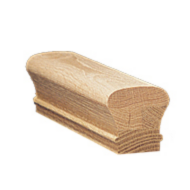
Handrail Handrails are what people use to assist them up or down a staircase. They are typically made from wood and can vary in style, along with curvature. 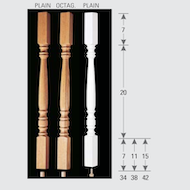
Balusters Balusters, also known as pickets or spindles, are mounted shafts that support the handrail on either side of a staircase. They can be made out of iron or wood, and come in a multitude of styles. 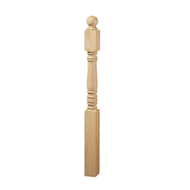
Newel Also known as a central pole or support column, a newel is the main support of the handrail, either at the end of the handrail or underneath the handrail. They come in a variety of styles and wood species and are typically solid. 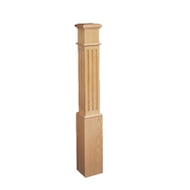
Box Newel A box newel is different in that most are hollow compared to normal newels. Box newels get the name due to the box shape that they have. They come in a variety of sizes and wood species. 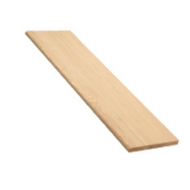
Tread The tread is the horizontal portion of a staircase that the person steps on to go up or down the stair. They can be made of wood or metal, with carpet being common in residential buildings. 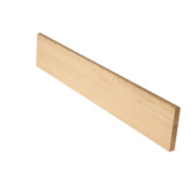
Riser The riser is the near vertical backboard that is between each tread. They connect the treads together and allows for a closed look, as well as increased rigidity. They typically match the tread's wood species and would be covered with carpet as well, if applicable. 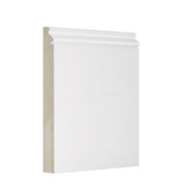
Skirtboard A board on the side of a staircase, a skirtboard is a non-structural trim piece to add a clean, luxurious look to a staircase. 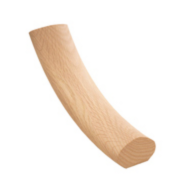
Handrail Fittings Handrail Fittings are pieces of pre-made wood handrails bent in specific ways to connect two straight or bending handrails. Includes up-easing, over easing, gooseneck, quarter turn, volute, and others. 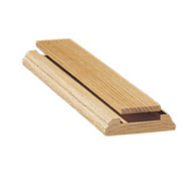
Shoerail Shoerails are the "handrails" for shoes on the lower portion of a staircase. It is a channel that allows shoes from balusters to sit flush in. They typically match the handrail's wood species for a uniformed look. Shoerails are not required, however. 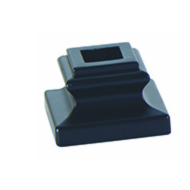
Shoe Shoes are decorative pieces that the baluster goes through, which covers the hole at the bottom of the baluster. Typically only paired with iron balusters, and can be placed inside a shoerail. Advanced definitions and terminologyLooking for a more detailed guide to all of the terminology in the star business? Look no further. |
|
| How do I buy/redeem a gift certificate? | |
| To purchase a gift certificate for someone, click here. If you are the recipient of a gift certificate and would like to redeem your gift certificate, click here. | |
| How do I find my product? | |
| To find the product(s) you're looking for, you may (1) use the navigation menus on the top, left & bottom of our website. (2) type a keyword into the SEARCH box. If you have any trouble locating a product, feel free to contact customer service for assistance. | |
| How do I navigate the site? | |
| To navigate this website, simply click on a category you might be interested in. Categories are located on the top, left & bottom of our website. QUICK TIP: Place your mouse cursor over anything you think could be a clickable link. You'll notice that anytime you scroll over something that is a link, your mouse cursor will become a "hand". Whereas scrolling over anything that is NOT a link will leave your cursor as an "arrow". You may also type a keyword into the SEARCH box to quickly find a specific product. If you have any trouble locating a product, feel free to contact customer service for assistance. | |
| How do I use a coupon? | |
| After adding items to your cart, click the "View Cart" link at the top of this site to view your cart. At the bottom of the shopping cart you'll see a box where you may enter your coupon code. | |